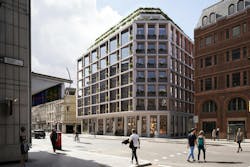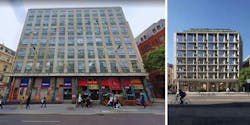Deep green retrofits: Updating old buildings to new sustainability standards
Constructed in the early 1960s, the building at 10 New Bridge Street in central London could have been demolished to make way for a more modern and efficient replacement. Instead, the office building is being renovated to new standards targeting BREEAM Excellent and WELL Platinum certifications for sustainability and wellness.
Eoin Conroy, UK country director for Atenor (the building’s developer) recently joined David Weatherhead, design principal for HOK’s London studio, for a LinkedIn Live conversation on the challenges and opportunities of retrofitting buildings like 10 New Bridge Street.
View their discussion (moderated by HOK’s Stephanie Miller) below or jump down for five key takeaways.
1. Green retrofits require more planning and creativity
From an architectural perspective, green retrofits of existing buildings often require more in-depth analysis than new construction.
“We need to spend a lot more time early on assessing the data,” said Weatherhead. “We need to assess whether it is practical to retrofit and how it will impact the building’s long-term adaptability.”
Even after an exhaustive study of the data, retrofits can still have many unknowns—such as what really exists beneath the walls. “You may think you know what you’re getting into, but when you dig further, it gets far more complicated,” said Weatherhead.
By melding modern solutions into historic architecture, retrofits also can create buildings that are more unique and attractive to tenants.
“It’s definitely not an easier path, but retrofits do lead to innovation and creativity in terms of the design approach,” said Conroy. “A building with character and identity creates value in the marketplace.”
2. Not all buildings are ideal candidates for green retrofits
“Fire regulations, accessibility standards and other codes were different in previous decades,” noted Weatherhead. “We can’t be short-sighted and say that we are going to keep a building but then realize that we are going to spend more carbon to bring that building up to modern standards.”
3. Retrofit isn’t always the least-expensive option
It is often said that the most sustainable building is the one that already exists. Yet renovating existing buildings to modern standards is not always financially sustainable.
“One of the myths of retrofitting an existing building is that it is easier and more cost-effective than demolishing a building and constructing something new,” said Conroy. “In fact, I’d say that’s rare.”
“Retention of anything is not a cheap option,” said Weatherhead. “We need to look at what is sensible and take a considered approach to what and where we want to develop.”
4. Green is just one component of sustainability
Beyond environmental sustainability, developers should be mindful of the social and economic sustainability of the project before committing to a retrofit.
“There are three pillars of sustainability—social, economic and environmental,” said Conroy. “When we talk about sustainability, most people automatically think about environmental sustainability. To make a building truly sustainable, it needs to be financially feasible and deliverable. There needs to be positive social impact. What’s the point of keeping a building if portions of the community simply cannot benefit from it because of accessibility issues?”
5. Sustainability codes and policies must be mindful of the existing building stock
Weatherhead and Conroy both spoke on the need for governments to take a balanced approach to sustainability by encouraging its adoption while also not making it impossible to apply to older buildings.
“Some of the policies are jeopardizing long-term sustainable development,” said Weatherhead. “We’ve got to make sure that the decisions we make today are not just for short-term sustainable wins. For example, is keeping an older building on life support better than demolishing it and replacing it with a building that can last another 200 years?”
“There is a lot of building stock that simply cannot achieve some of the new standards,” said Conroy. “That’s good for the building owners who have updated stock and can take on tenants, but not so good for those who have historical stock and are going to lose tenants while taking on major capital improvements. From a planning and policy implementation perspective, what can be done is a bit of a reality check around the timing and the basis for new policies. The agenda can still move forward, but it does so in a much more balanced, regulated and sustainable way.”

